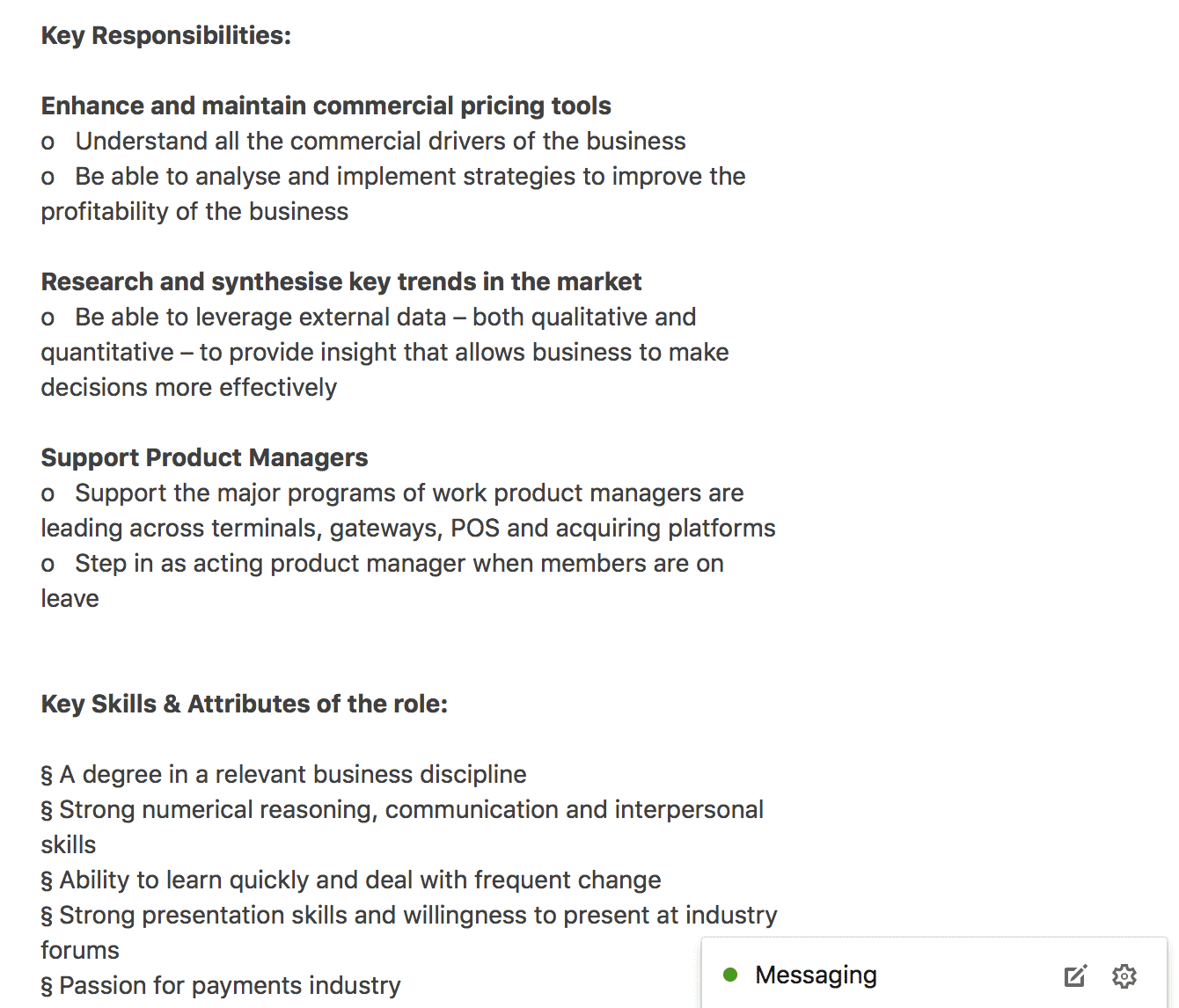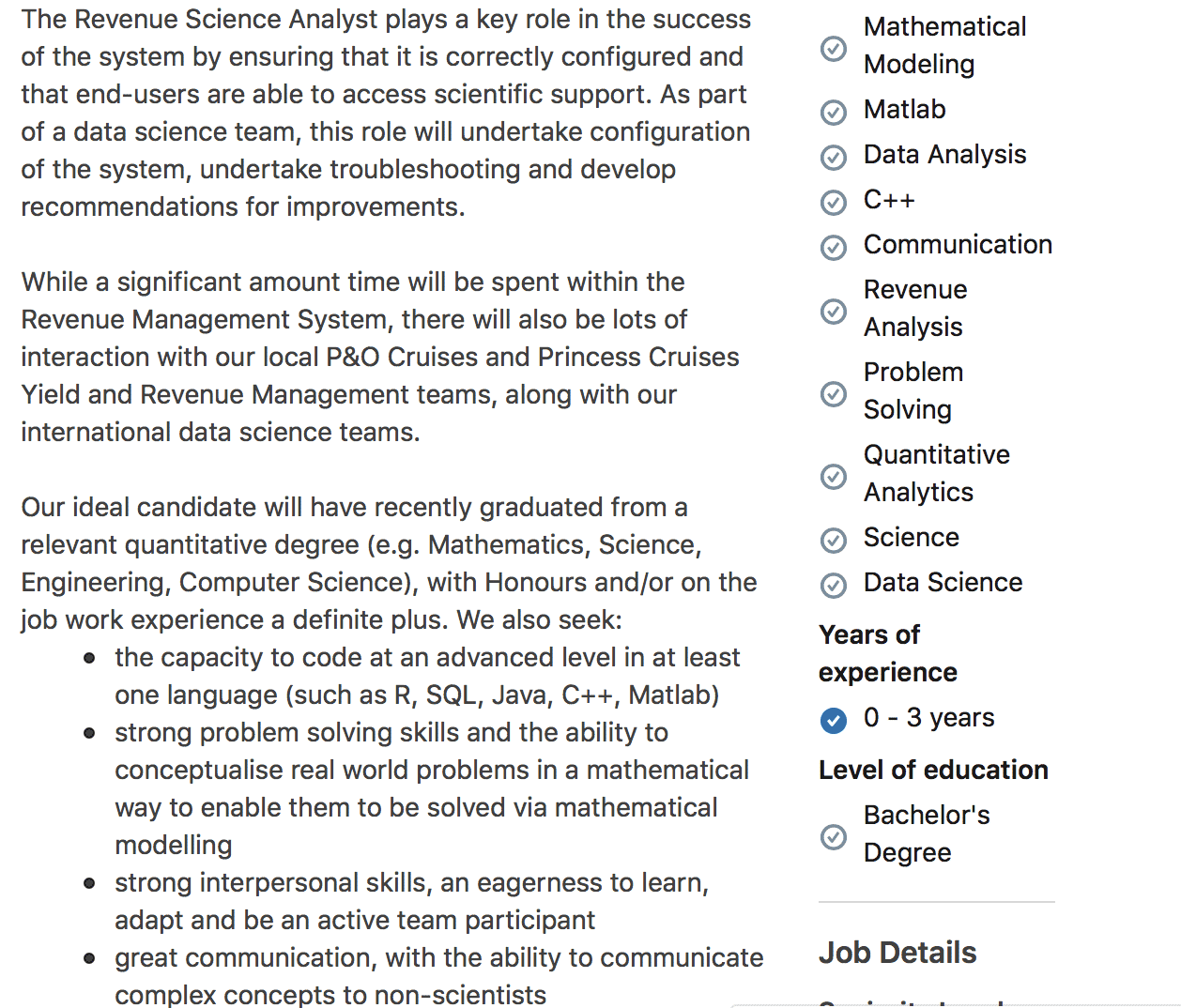
Pricing Analyst Job Description: What does a pricing analyst do?
>Download Now: Free PDF How to Build Hiring Capability to Get The Best Pricing Team
Becoming a pricing analyst is a great career choice for those looking to work with numbers in a fast-paced job that offers plenty of room for growth and demands accuracy and accountability.
It is a career just made for those with an analytical mind, business acumen, excellent communication skills and a passion for numbers.
Pricing Analyst professionals are driven and high achieving by nature (pricing competency). Often they can find the prevailing culture at their new company, not all they had hoped it would be. Many industries traditionally have valued tenure, “industry” expertise and personal contacts very highly. This has been particularly true in sales pricing strategy environments. This traditional approach can be in juxtaposition to a pricing hire, which is typically viewed as number cruncher/information gather/cost.
In this article, we will talk about the pricing analyst job description and what he/she does. We will also discuss the key duties and responsibilities of a pricing analyst. In addition, we will share with you the reasons why interpersonal skills are important in the pricing analyst job description. By the end of this article, you will gain knowledge on how to hire the right pricing analyst professionals.
Table of Contents:
I. Pricing Analyst Job Description: What does a pricing analyst do?
II. Pricing Team Job Description: What Is a Pricing Team?
III. Why The Embattled Pricing Team Is Public Enemy No.1!
Capability Building Programmes For Pricing & Sales Teams!
Pricing Analyst Job Description: What does a pricing analyst do? 👔
Pricing Analyst Job Description
A pricing analyst is responsible for determining the ideal target price for products of the business to analyse competitor pricing matched with market expectations.
Pricing analysts work with complex data sets to help businesses determine and set competitive prices to gain market share and achieve revenue goals. This is a highly analytical role that requires pricing analysts to consider data from multiple sources and develop complex pricing models that reflect margins for promotional and seasonal pricing based on competitor, market, and customer data.
Pricing analyst job description also includes working in a variety of fields, including retail and business-to-business (B2B) sales. In any setting, pricing analysts collaborate with sales and marketing teams to develop strategies that drive sales and ensure that their companies remain competitive.
How Many Pricing Analysts Do you Really Need? 👩💼 Podcast Ep. 40!
Pricing Analyst Duties and Responsibilities
What’s the pricing analyst job description or the duties and responsibilities? While the day-to-day responsibilities of a pricing analyst depend on the type of business they work for, many of the core duties carry over:
- Analyse Pricing Data – The pricing analyst uses a number of quantitative and qualitative methods to analyse competitor pricing, assess market share and margins, and track customer engagement in order to gain a complete picture of effective pricing strategies for their company’s offerings.
- Develop Forecasts and Models – Pricing analysts play an important role in helping companies forecast revenue and market share information. They use a variety of statistical modelling methods to prepare reports that show the potential impact of various pricing strategies, including their effect on margins and costs and how they will impact profitability and sales volume.
- Determine Pricing and Marketing Strategies – In this role, pricing analysts work closely with sales and marketing personnel to develop and enact competitive pricing strategies.
- Monitor Industry Trends – If the pricing analyst discovers a trend that they believe has the potential to improve sales volume or profitability, they may recommend pricing strategies that align closely with these trends. By actively monitoring industry trends, pricing analysts may also develop strategies that take advantage of untapped market segments and help the company gain market share in new avenues.
- Develop Pricing Tools – Many pricing analysts use developed pricing tools throughout the company to more quickly respond to changing market needs or trends. These tools can include dynamic pricing that allows the company to quickly adjust prices to enhance sales volume and conversion rates.
- Present Findings to Key Decision-Makers – This aspect of the role requires pricing analysts to translate complex data into actionable strategies and techniques to drive sales and enhance marketing efforts. Pricing analysts may prepare both written reports and visual presentations to share their findings.
Click on the link to know if Millenials are a Nightmare to Hire – CEO Australia.
What is Price Management?
Pricing Management is a price operating platform that oversees price setting practices and price strategies, people, models and operations. A price operating platform integrates multiple perspectives, data and information sources necessary to consistently arrive at optimal pricing decisions for profitable revenue growth.
To make it as a successful Pricing Manager and Pricing analyst, there are many desirable skills/traits to have in your arsenal.
You don’t have to be larger than life in this role but you should be a straightforward and strategic planner. Be on top of your game, innovative and confident. Remember also, you need to be flexible in your approach. Be confident and competent – but leave your ego behind the moment you enter the office!
Pricing Manager and Pricing analyst may be responsible for ensuring the productivity and efficiency in a team; as well as guiding the business on price policies, process and procedures. It also helps if you are a good communicator with excellent interpersonal skills; comfortable working both in a team and independently. Moreover, if you work in a team you have to be a role model for your team members.
Like any other pricing jobs, a Pricing Analyst is successful only when they are a strong source of inspiration and motivation for the team members and peers. You must frequently communicate with other teams and senior management to acknowledge successes and failures, provide options and solve problems to move the business forward.
Why are Interpersonal Skills Important in Price Management?
There are certain skill sets that are crucial for professionals to be able to exercise in their work environment. Regardless of your industry, interpersonal skills (such as being able to effectively communicate) are important because they:
- Help employees develop and foster strong working relationships with each other and with their clients
- Contribute to increasing team and organisational productivity, and
- Create an overall positive work environment.
Must-have interpersonal skills in B2B pricing and selling environments:
- Exercising Self-Awareness – Being aware of your own feelings and emotions can help you be mindful of the messages you convey to others whether through your words or non-verbal forms of communication. A lack of employee self-awareness can be detrimental to the success and productivity of an organization.
- Cognizant of Nonverbal Communication – Nonverbal cues can either make relationships stronger or damage them depending on how they’re used and the context of the situation.
- Respectful of Others – Respect can go a long way in fostering positive relationships and work environments.
- Clear Communicator – Having effective communication skills can be the difference between success and failure.
- Being Receptive to Feedback – Feedback is necessary for personal and professional growth. It provides corrective; constructive input based on an evaluation of information; whereas the one being geared more toward delivering judgement based on that information is criticism.
Why are Interpersonal skills vital in Pricing Analyst Job Description?
Interpersonal skills are vital because they affect job performance which in turn helps to decide the outcome of a company’s success.
Superb interpersonal skills encompass listening skills, problem-solving, decision-making and negotiation skills. In addition to that, communicating internally with employees and coworkers is just as important as building and maintaining solid relationships with customers.
Key Pricing Analyst Job Description for Hiring Pricing Analyst Professionals
We believe the prerequisites for a successful pricing analyst hire include:
- Senior advocacy from top-level management in a new company for pricing strategy
- Clear guidelines and understanding as to what remit of new pricing analyst is
- Intellectual curiosity
- Domain knowledge and/or a strong reason/passion to pursue a career in the latest pricing and revenue management
- Interpersonal and communicative skills
- Patience and ability to see long term
- Candidates with a strong grasp of value-based pricing (analytics and philosophy), business acumen, and excellent problem-solving ability.
We also think it is important for companies to identify the next generation of pricing expertise. By this, we mean to find candidates with rare ability to make sense and draw pattern between markets and commerce. So, the intangible, unseen opportunities and potential in all economic and market conditions are put into use. Innovation is constant, and unstable markets will demand expertise beyond even the most capable value-based pricing specialist.
Our research shows that exceptional pricing and commercial executives are 300% more productive than average performers 1 1/2 times better than core performers and 900% more productive than poor performers.
Most commercial functions are still dominated by cost-plus pricing specialist. As a result, a growing number of successful businesses are employing value-based price management specialists. Only a handful are hiring what we call ‘practical innovators’. People with the ability to adapt and produce innovative pricing patterns and alternatives that respond to changing and unstable markets. And expertise that goes beyond the typical textbook definitions of value-based pricing.
Whilst “Rome was not built in a day”, neither can a market-leading, best pricing commercial approach is built quickly. A pricing manager should prepare to work over the medium and long term (3-5 years) to deliver the full benefits. Therefore, a receptive culture and management focus will further speed up this process.
Pricing Recruitment For Pricing Managers!
Implications
Interpersonal skills are essential regardless of your industry. They help employees develop and foster strong working relationships with each other and with their clients. Also, contribute to an increasing team and organizational productivity, and create an overall positive work environment.
Furthermore, interpersonal skills affect job performance which in turn helps to decide the outcome of a company’s success. Excellent interpersonal skills encompass listening skills, problem-solving, decision-making and negotiation skills.
It is vital for businesses to determine the next generation of pricing expertise. Thus, companies should find candidates with rare ability to make sense and draw pattern between markets and commerce.
〉〉〉 Get Your FREE Pricing Audit 〉〉〉
Conclusion
To be a successful pricing analyst, you should be a straightforward and strategic planner. Also, you should be on top of your game, innovative and confident.
A pricing analyst job is a highly analytical role because they work with complex data sets. In order to help businesses determine and set competitive prices to gain market share and meet margin goals.
The primary duties and responsibilities of a pricing analyst include analysing pricing data, developing forecasts and models, determining pricing and marketing strategy, monitoring trends, developing pricing tools, and presenting findings to key decision-makers.
Capability Building Programmes For Pricing & Sales Teams!
Pricing Team Job Description: What Is a Pricing Team?
Finding the right people for a role goes well beyond the job description and CV. Hence, when creating a pricing team job description, it is essential to measure the right things and be aware of what they are. Additionally, utilising alternative talent networks and evidence-based testing will help measure the right skills and characteristics which will help create a thriving, specialist pricing team.
The first step is for businesses to realise that they won’t find everything they require in just one person. With that in mind, it’s a far better, and more effective, option to utilise a team and have subject matter experts within it.
How Many Pricing Analysts Do you Really Need? 👩💼 Podcast Ep. 40!
A strong pricing team job description builds the perfect team
A good pricing team acts as internal pricing consultants for your business. They are responsible for:
- The application of pricing concepts
- They determine pricing systems relevant to the business
- How pricing helps achieve business goals
- Set, support, and execute pricing tools and methods
B2B Vs. B2C
Pricing teams need to operate differently depending on whether your company is B2B (business-to-business) or B2C (business-to-consumer). Therefore, your pricing team job description should reflect your needs.
The pricing process and model of a B2B business need to consider the ff:
- The longer decision-making process involved in the sale i.e, building value equity with the customers in advance of a major tender
- Creating a vision for change and improving internal price management practices
- A larger number of stakeholders with a range of views on pricing and how it should be done
- Sales team performance and changes in the market
- Upstream supply, commodities prices, trading and impact of CAPEX on cost structures
- The requirement of a more extended relationship with loyal or preferred customers
- Limited lead opportunities and tighter deadlines
- More price transparency in the market
- Increasing competition
- A changing sales and deal process
- A different kind of product awareness – i.e., customers are able to go online to compare products and their prices via aggregator sites
- Channel conflict
- Business model disruption i.e., platform business cutting out the middleman distributors and going direct to market.
- Procurement teams cherry-picking prices at a line item level
B2C pricing teams, on the other hand, need to consider:
- Quick exchange or transaction (often one-off)
- Multiple pricing decisions a day
- Price indexing
- Competitive intelligence
- Alternative revenue models (i.e, subscription versus fixed fee
- Dynamic pricing models
- Tactical discounting
- Bundling and unbundling value
- A highly systems-driven approach to pricing and operations
- Sophisticated price software, statistical analysis, visualisation and data tools
- A modified approach to their consumers driven by customer data and sensitivity analyses
- Implementing advanced customers segmentation principles (i.e., micro-segmentation)
Less than desirable job descriptions
If you write a terrible pricing team job description, you will likely secure a poorly skilled team. Therefore, bad descriptions fail to attract highly qualified candidates while bringing in unqualified applicants by the hoards. Thus, save your valuable time and avoid some of the traps of lousy job postings like these examples:
The above advertisement offers a very broad scope. It essentially requests that the new staff member should be ready to do everything, i.e., modelling, governance, risk management, pricing, stakeholder management.
This gives the impression that the company doesn’t actually know what they are looking for and are trying to deal with a number of issues. So, who do you think this problem will be passed on to? Not a pleasant environment in which to start a new role.
The job title of this one alone should set off alarm bells. Hence, the role requires the building of a custom revenue management system for very complicated pricing and revenue management models. Thus, this places the responsibility of the configuration on an analyst when other businesses are hiring highly specialist pricing implementation consultants with technical knowledge and IT pricing skills for this single task.
So they are asking for a pricing analyst, coder, programmer, mathematician, and data scientist. Plus great interpersonal skills!
This ad is asking too much and will likely lead to cost blowouts and painful change management. Not to mention zero-margin gains.
Consider the quality of person you want in your team. Think about the precedent you set on what behaviour (humour included) is appropriate when they are at the workplace. Therefore, treat others the way you want to be treated, and write job descriptions for the type of people you want to be working with.
Five ways to make your pricing team job description better
As we mentioned earlier, selfish job descriptions will be less appealing to good talent, as will descriptions that are overly descriptive. Consider the following when crafting your next advertisement:
-
Don’t be too particular
Avoid creating diversity issues before creating your team. Additionally, heavily experience-focused ads will focus on the wrong mix of skills and attributes. They often emphasise technical skills over people skills or fail to define the characteristics required.
Pricing Recruitment For Pricing Managers!
-
Consider the tone
An arrogant sounding job ad creates a personality for your business that may not be accurate. In effect, try to avoid writing in a tone that is dismissive or flustered. Many ads give the impression that the poster is already annoyed by the number of low-quality applicants they will receive and is instantly demanding or fed up.
-
Be concise
Prospective candidates are likely to be seeking jobs online and reading a whole stack of job advertisements. Keep your job posting as short and to the point as possible. The easier it is to understand, the higher the chance of someone reading the whole thing, thus absorbing all of the information that you want them to know.
-
Answer the questions your candidate may have
Ambiguity is simply annoying. Identify what information your potential new employee may need and include that in the advertisement. Offer the key facts and entice someone to the application phase by giving them all the information in the first step.
-
Grab their attention
There is no rule anywhere that says job ads should be walls of text, yet so many of them are. Why not stand out from the crowd a little and be creative? Keep in mind that you are giving people a sense of your business personality, and possibly what the culture and work environment will be like. If your ad is boring, what does that say about your business?
〉〉〉 Get Your FREE Pricing Audit 〉〉〉
Key points
Better job descriptions, better teams.
Always remember the importance of identifying individual strengths while understanding the individual weaknesses of applicants and team members. Aim to build the kind of team that will drive a diverse way of thinking.
Create a candidate experience that attracts high calibre people and educate them on the challenges of the role and what’s expected from them both intellectually and emotionally.
Capability Building Programmes For Pricing & Sales Teams!

Why The Embattled Pricing Team Is Public Enemy No.1!
Why The Embattled Pricing Team Is Public Enemy No.1? – The origins of the turf war between pricing and sales.
So why don’t businesses just set up a top-notch pricing team to work with sales to implement more sophisticated market strategies that capture margin?
Pricing team: Assumptions, perceptions, fears and cognitive biases rooted in our evolutionary past may be partly to blame for poor teambuilding and dysfunctional team behaviours.
How Many Pricing Analysts Do you Really Need? 👩💼 Podcast Ep. 40!
Perceptions of competition drive a lot of our thinking and are difficult for us to avoid. It can be the causal driver for turf wars and resistance to change and can even be the reason we look for excuses not to work collaboratively across an organisation. As a result of our past hang-ups, teams and the members within have a tendency to think of their internal processes networks and connections as a zero-sum game – i.e., if one team gains something, another must lose out.
In terms of the pricing-sales team relationship (see blog on price reduction), a pricing team may gain control of pricing decisions as part of a wider business process improvement while the sales team loses their discretionary pricing power. Often this handover of perceived pricing power empowers a pricing team and dis-empowers a sales team. These perceptions stem right back to our evolutionary past. They evolved to protect us from threat and enemy attack.
Pricing Recruitment For Pricing Managers!
All the evidence suggests that a high-performance pricing team boosts revenue and maximises margins.
Such perceptions were accurate during our evolutionary past: When we were hunter-gatherers and the appearance of other people and animals on our patch meant fewer wilder beast for us.
In our distant past, sharing and collaborating was not something we really did. We might have shared with our close relatives – or at least our common genes would benefit from our close family succeeding in life. But anyone else, and in particular, anyone displaying behaviours counters to our perceived norms was likely to be considered a competitor.
A modern business is not necessarily a zero-sum game per se – when you optimise price, for instance, net profitability should grow.
Regardless, there are things we can learn from our evolutionary past. Indeed, our human hang-ups are the very things making it difficult for other teams to thrive. It can be difficult for all teams – i.e., the executive, sales, marketing and financial teams – to accept or even believe the financial gains in welcoming a new pricing team.
That’s not all, groups also evolve different survival-enhancing practices. This means that new pricing teams (and even new pricing team members joining an established pricing team) can often be considered a threat to the status quo.
Firstly, new pricing teams exhibit different rules and behaviours that can interfere with the business’ habitual coordination and management of price.
Secondly, new teams think differently from everyone else in the business about how to define, communicate and capture more revenue and margin.
Thirdly, they actively seek to influence and persuade different areas of the business to follow their pricing rules instead of legacy pricing rules and systems. Check out our blog on why pricing and business economics 101 may sometimes be wrong.
A clash of forces can occur when the sales team perceives the pricing team are making authoritarian pricing decisions, which preclude them.
〉〉〉 Get Your FREE Pricing Audit 〉〉〉
There are clues in our evolutionary past which reveal the perennial difficulties associated with teambuilding and change management. Humans have evolved to be risk-averse, wary of close interactions with people who may think or behave differently from the accepted norm. Human hang-ups hack our brains daily and warp our perceptions of life and business.
It is common to witness visible tension between pricing and sales teams: Sales teams can feel threatened by new pricing teams demonstrating different values or new methods of pricing. Pricing teams, in response, often turn inward and become tired of fighting the battle – forming tight enclaves rather reaching out to other teams.
Silos and insular thinking can foster strong internal resistance to any proposed pricing changes and leadership. Toxic subcultures can emerge when teams clash and team performance soon suffers. Even the term ‘price management’ can engender a wider mistrust in stakeholders when perceptions are not managed properly.
Businesses and teams within commonly revert to what they did before and shut out new ideas. Even though what they did before was broken. To build a culture of collaboration in modern pricing organisations, we need to learn to get past our natural biases. This, combined with a real empirical understanding of the impact of teambuilding, might finally allow sales and pricing teams to capitalise on the huge financial potential that they can generate for the business and the whole value chain.
Click here to access your free document on recruiting pricing all stars to boost profit.
For a comprehensive view on building a great pricing team to prevent loss in revenue,
Download a complimentary whitepaper on How to Build Hiring Capability To Get The Best Pricing Team.
Are you a business in need of help to align your pricing strategy, people and operations to deliver an immediate impact on profit?
If so, please call (+61) 2 9000 1115.
You can also email us at team@taylorwells.com.au if you have any further questions.
Make your pricing world-class!





